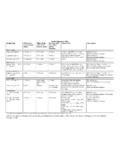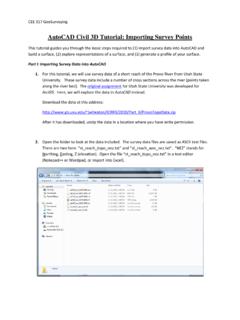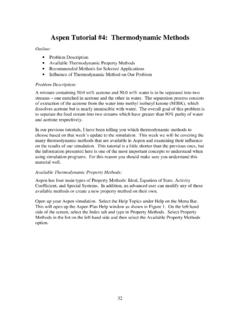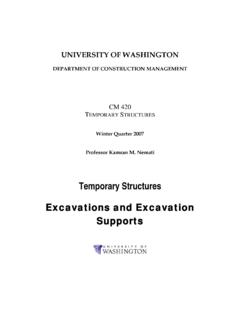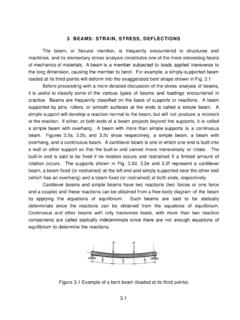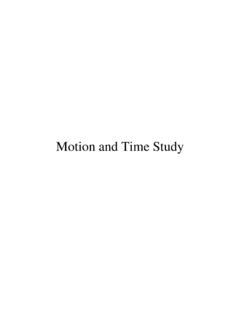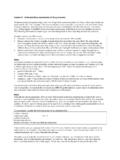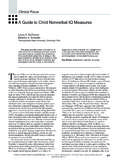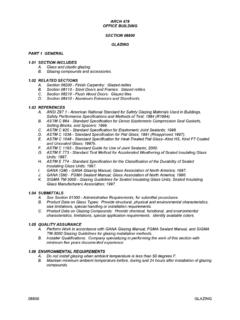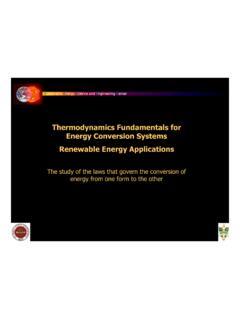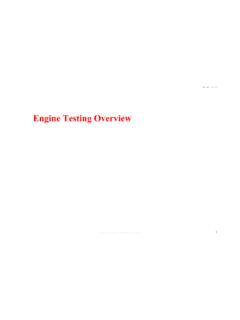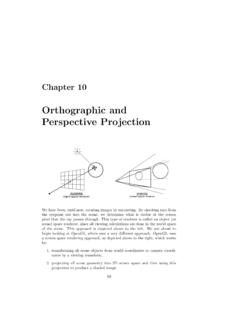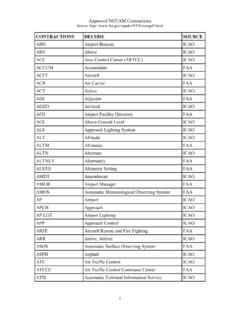Transcription of Gaussian Plumes from “Point” Sources
1 1 GaussianPlumes from Point Sources Time averaged vs instantaneous Plumes Simplified steady-state plume model Eddy diffusion, advection/diffusion equation Gaussian point source plume model plume sigma values vs stability and distance plume reflection Non- Gaussian Plumes plume Rise; plume trajectories Buoyancy-induced dispersion Stack downwashView from below of Coning plume under neutral atmospheric conditionsSource: Slade et al Meteorology and Atomic Energy, 1968 instantaneoustime-averaged2 InstantaneousPlume ShapeTime-averaged plume ShapeFig 4-3, in Martin et alwindDescribing plume Concentrations3 Tim s Simple plume Modelhx123mass/timepassingpoint 1=mass/timepassing thrudisk area 2mass/timepassing thrudisk area 3C1 > C2> C3=Simplified Steady-State plume Model*Pollutant is well mixed and confined within the cone*Pollutant is continuously swept thru the cone by the windConcentration vs. distance downwind depends upon cone shape4()()2disk of areaspeed windrateemission Mass 2at air ofion Concentrat=12 Simple Model #1:()()23mm/sec g/secm g=Disk shape depends upon stability categoryMore unstable and thus more pronounced vertical spreading5 PerspectiveView of Fanning plume in Very Stable AirSource: Slade et al Meteorology and Atomic Energy, 1968 Less verticalmotion6unstableneutralstableAATi me-averaged concentration across AAGaussian (normal) distribution occurs across AA due to changes in wind direction over averaging timeShape is described by plume sigmas Most probable wind directionsourcewindMass is not uniformly distributed within the cone s volume More Detailed plume Model7()()[]functionon distributiGaussian 2disk of areaspeed windrateemission Mass 2at Conc=12 Simple Model #2.
2 XzyXis the time-averaged wind direction,Yis the cross-wind direction,Zis the vertical dimension()()[] =23mm/sec g/secm gGaussian plume Model12In order to derive an equation describing the distribution of mass within the plume , we must first consider the transport of mass within a small control volume8xzy*Transport of mass in x direction depends on the average horizontal wind*Transport of mass in the y and z directions depends on turbulent motionsdxdydz Eddy DiffusionPollutant molecules are moving around in random directions due to random eddy motionsConsider two enclosed air volumes separated by a wall(arrows represent eddy motions; balls represent pollutant molecules)Random eddy motions in pollution-free airNow remove the wall between the enclosuresSize of eddies > size of pollutant molecules9 The rate of pollutant molecules crossing plane AA depends upon the concentration difference between the two sides. Specifically, this rate =K c/ x ,where K is termed an eddy diffusivity with units of m2/sec.
3 The magnitude of K depends upon the magnitude of the eddy in this case, the rate of net rate of pollution crossing AA is zero (an equal number of molecules cross in both directions). However the value of K remains constant throughout the experiment dxdydzChanges in x Direction:Net rate of change of mass flow = (Mass flow rate in) -(Mass flow rate out) Mass Flow Rate In = C u Ayz{ [ g/m3] [m/s] [m2]}()dxxyzyzAu C Au C Out Rate Flow Mass +=()()V u C-Au C- Change of RateNet yzxdxx = =V = volume = dxdydzAxy= dxdyAyz= dydzAxz= dxdz10dxdydzChanges in z Direction via Turbulent Diffusion :V = volume = dxdydzAxy= dxdyAyz= dydzAxz= dxdz{}]sec ][mm g][][m[m C K zA- In Rate Flow Mass1-23-1-2zxy =() V C K zz Change of RateNet z =A similar result is obtained in the y direction. Given that thenet rate of change in the volume [ = V( c/ t)] is the change in all three directions , we obtain an overall expression in terms of x, y and z. + + = zCzyCyxCuCzyKKt Advection-Diffusion Equation+ other losses due to deposition and chemical reactions= 0 for steady-state models Advection , , transport by the mean wind, uEffect of turbulent diffusion , , exchange of polluted air parcel with surrounding air parcels.
4 If the surrounding air is cleaner, C/ z & C/ y are negative. K is the eddy diffusivity and represents the intensity of turbulent motions and varies with stability11 The Gaussian plume equationis a particular solution to this more general equation under the following assumptions:0C= t* Constant wind speed with height (u does not depend on z)* Steady state conditions* Constant eddy diffusivity (K does not depend on y or z)* Mass is conserved{}g/sec 0][for x QC >= dydzDefine:u xK 2 z2z=u xK 2 y2y= Gaussian Point Source plume Model:Wind speed evaluated at effective release heightMass emission rate}Corresponds to disk area in simple model (values depend upon downwind distance, x)Distribution of mass in vertical dimension (z) at a given downwind distance, x (includes the effect of surface reflection)Distribution of mass in cross-wind dimension (y) at a given downwind distance, xPollutant concentration as a function of downwind position (x,y,z)()()() + + =2y22222zy2 yexp2exp2expu 2Q z)y,C(x,zzhzhz Effective stack height, including rise of the hot plume near the source12 Gaussian plume (Concentrations vary with x, y and z)For a given x, the max conc.
5 Is at the plume centerline and decreases exponentially away from the centerline at a rate dependent upon the sigma values, yand z. yand zare functions of xPlumeCenterlineCross-wind distance from plume centerline (m)Vertical distance from plume centerline (m)Concentration distribution in a Gaussianplume ( y= 20 m; z= 10m; centerline concentration = )Source: Hanna et al, 1981 Note: theoretical plume has infinite extent in all directions! y z13 Sigma-yxSigma-z14() = ()() = xis in kilometers yis in meters is inradiansCross-wind distribution:bzax= Vertical distribution:xis in kilometers zis in metersa, b depend onxPlume sigma formulas from EPA s ISC ModelPasquill Stability Category x (km) a b A* <.10 - - - - - - - > ** ** * If the calculated value of z exceed 5000 m, z is set to 5000 m. bzax= 15B* <.20 - > * All <.30 - - - - > * If the calculated value of z exceed 5000 m, z is set to 5000 m.
6 ** z is equal to 5000 m. Pasquill Stability Category x (km) a b bzax= Pasquill Stability Category x (km) a b E <.10 - - - - - - - > <.20 - - - - - - - - > bzax= Stability Category()() = plume Reflection off of the Ground(pollutant cannot penetrate the ground)Actual Source Virtual Source(below the surface)Most of plume above the surfacePlume begins to reflect off the surfaceReflected material (shaded area)Resulting in an asymmetric vertical profileReflection is modeled by adding a virtual source contribution to the real oneh17xA virtual source can also be used to model the effect of hot, rising plumesPhysical stack height,hsPlume rise, h Effective stack height, hConcentration vs. x at ground level (z=0)(note maximum at x > 0)Concentration in elevated plume at height zExample Calculation()()() + + =2y22222zy2 y-exp2exp2expu 2Q z)y,C(x,zzhzhz Given:Q = 10 grams/sec; h = 50m; x = 500 m = km; u100= 6 m/s.
7 Stability Class D Compute:C(500, 0, 0) , , the ground level concentration at plume centerline, 500 meters ) ( [] ) ( [] ) () ( )( y== =x()()()()()()()()() + + = 210 C(500,0,0) ()()(){}{}335 210 C(500,0,0) === 18 Virtual Source Also Used to Model ReflectionOff of the Top of the Mixed Layer(added to direct plume concentration)Eventually well-mixedPlume Reflection off of the top of the mixed layerwindzii19 plume Trapped in Stable Layer Above Mixed LayerTime of DayDateLatitudeLand UseCloud CoverHourly Wind SpeedPre-dawn d /dzStability CategoryMixing DepthWind Speed ProfileAtmospheric Dispersion ModelMinimum Necessary Information Needed to Implement a Simple Atmospheric Dispersion ModelWind DirectionSource Emission RateSource Geometry20 Non- Gaussian PlumeswaterlandsourcewindVery Narrow Stable plume over Water (as viewed from above)21 Water (stable)Land (unstable)source Fumigation plume Fumigation During On-shore FlowwindPlume Trapped in Building Wake22 plume Looping During Unstable Conditions(large-scale vertical motions)ExtremeDepartureFrom Gaussian23 Many tall industrial stacks release hot, effluents into the air rises and cools.
8 There are two well established results from the science of plume rise: the immediate downwind trajectories of "bent over" Plumes and the maximum attained height of "vertical" Plumes . plume Rise in Neutral or Stable AirVertical plume Rise, h Bent over plume trajectory, z zxxfinalhs hz hsh h(z is a function of x)Low wind speeds in stable airHigher wind speeds in stable/neutral airwind24 Near the stack (x< xfinal) , the plume trajectory is dominated by buoyant rise as shown in the equation Bent over plume trajectory under stable and neutral conditionshxfinalhs hu xF '320=zF0is the initial buoyancy flux at the stack exit [m4s-3]The final plume rise, h, is a complex function of wind speed and stability and applies when x > xfinalThere is also some rise due to momentum (stack gas velocity), but this is usually small compared with the effect of Flux, F0()()20000R wTTTgF =T0= Stack gas exit temperature (K)w0= Stack gas exit velocity (m/s)R0= Stack radius at exit (m)The larger the stack radius, the more time it takes for the gas to cool by mixing with surrounding, cooler air25 Dimensionless downwind parameter (x )
9 Dimensionless plume rise parameter ( h [u s] )Observed plume TrajectoriesSource: Simon and Proudfit (1967); data from Ravenswood power plant, New York () = s is the stability parameter, a continuous descriptor of the strength of the atmospheric restoring force under stable conditionsVertical plume Rise Under Stable Conditions hhs26xA virtual source can be used to approximate the effect of plume rise on downwind concentrationsPhysical stack height,hsPlume rise, h Effective stack height, hBuoyancy Induced DispersionNear the source, the rising plume entrains surrounding air as itrises. This dilution of the plume is not accounted for in the classic plume dispersion equations. To account for this extra dilution, an additional term is added to the plume sigmas ( plume spreading parameters) that is a function of plume trajectory as follows:() 'zeffectivezz + =() 'yeffectiveyz + =27 Stack-Induced plume DownwashWind flowing past a stack can create a region of lower pressure immediately downwind of the stack.
10 If the vertical momentum of the stack gas is not sufficient, the plume will be drawn downward on the downwind side of the stack, lowering the effective stack height, w0< u += 'uwDhhssFor w0>= uhs = hsWhere hs is the adjusted physical stack height (not including plume rise)

